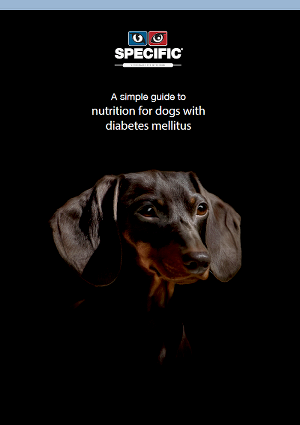What is diabetes in dogs?
Just as cars use petrol or diesel for fuel, body cells run on a sugar called glucose. Glucose comes from the body breaking down carbohydrates in the diet. Cells then extract glucose from the blood with the help of insulin - a hormone made by the pancreas. In diabetes, insulin is either absent or not working properly. This means that cells don’t take in enough glucose, which then builds up in the blood causing organ damage. Diabetes is not curable, but it is treatable – and a dog with diabetes can live many happy years after diagnosis.
What are the symptoms of a dog with diabetes?
If your dog shows the following symptoms then we recommend you visit your vet, as they could be indicators that your dog has diabetes:
- Change in appetite
- Excessive thirst/increase in water consumption
- Weight loss
- Increased urination
- Unusually sweet-smelling or fruity breath
- Lethargy
- Dehydration
- Urinary tract infections
Click here for a free diabetic monitoring diary
What can I do to help my dog with diabetes?
Like humans, when dogs have diabetes, staying healthy is key. If your dog is overweight, losing some pounds can help his cells use insulin more efficiently, making it easier for his body to turn food into fuel.
The goal for any dog with diabetes is to keep blood sugar (or glucose) levels as close to normal as possible. This helps your dog feel good and makes it less likely he'll get diabetes related complications.
Recommended food to help dogs with diabetes
How can I control my dog’s diabetes?
Dog diabetes is typically tackled with a combination of insulin treatment and diet. Working closely with your vet, you will be able to find the right balance for your needs on insulin. The aim of the diet is to control the dog's blood sugar level. Dog food with a low “glycaemic index” is crucial to keeping the blood sugar down.
What is the glycaemic index?
The glycaemic index (GI) is the measure that shows the effect on the blood glucose after consuming food. A lower GI food releases glucose more slowly.
How nutrition can help
The most important thing is to control blood sugar, avoiding sudden highs and lows. Diets with low GI, that slowly release glucose, will help achieve this.
Dogs with diabetes will have a greater risk of having high cholesterol and high blood pressure so look for foods rich in Omega 3 fish oils to help.
Diabetes and other Endocrine disorders can also reduce the performance of the immune system. There are a number of immune supporting nutrients that can help including Omega 3 fish oils; beta-glucans, zinc and selenium.
All Endocrine disorders can impact on coat and skin condition – again Omega 3 fish oils can be a great help here.
Recommended food to help dogs with diabetes
Other hormonal disorders
The hormonal disorders Cushing’s disease and hypothyroidism can lead to similar associated complications as diabetes.
Cushing’s disease:
When the level of the hormone cortisol is too high (also called hyperadrenocorticism)
Hypothyroidism:
When the level of thyroid hormone is too low.
If your dog has one of these disorders, they can also benefit from the Endocrine Support diet. This food provides the nutrition necessary for dogs already in medical treatment to maintain a stable, healthy life.
Recommended for dogs with Diabetes or other Endocrine disorders
SPECIFICTM diets is only available at selected vets
(Who really love dogs)
Launched in 2015 the Circle of Good was a commitment to pursue sustainable manufacturing and sourcing and to use a share of profits supporting marine sustainability initiatives."
Dominic Ebery
SPECIFICTM Nutrition Team, Dechra





